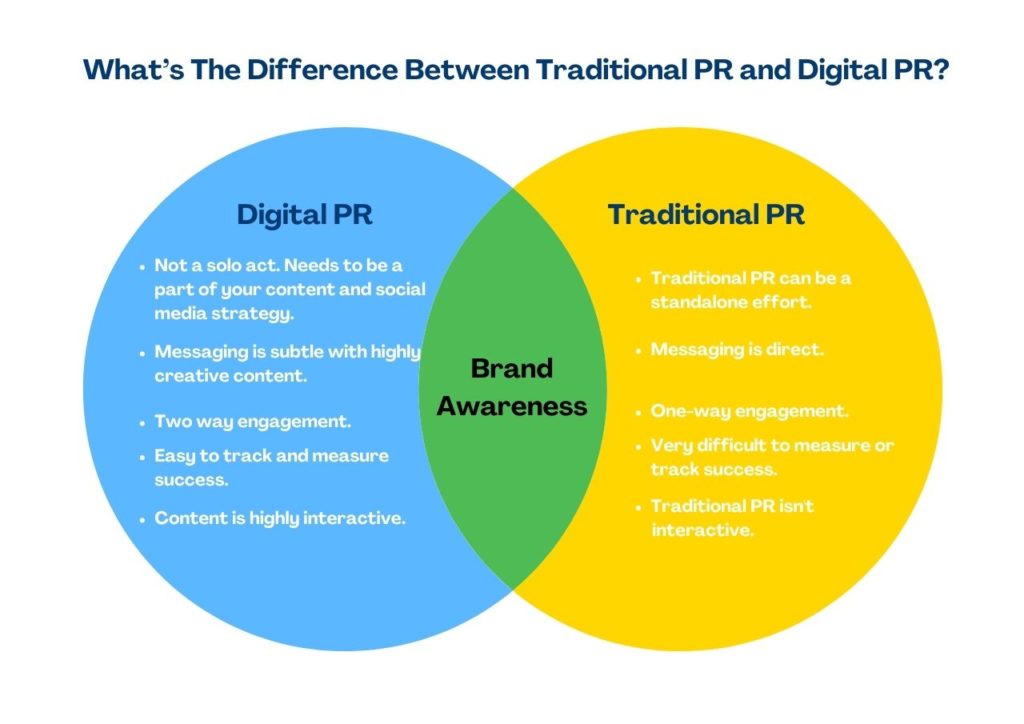Every brand/business wants to be liked and to be known or recognised, regardless of what they do, or who they serve. And this is what PR does – Maximize brand awareness and create a positive impression on your brand.
So, PR is PR, right?
No. Even though Digital and Traditional PR share the same goal -engage relevant audiences with strategic storytelling that builds brand awareness and positions the brand in a favourable light, There are many differences between the two types of PR.
Before we dive into the similarities and differences,
What is Digital PR?
We’ve established that PR builds brand awareness. So, Digital PR (Digital Public Relations) is a strategy used to increase brand awareness using online methods. To reach audiences online, digital PR ties into digital marketing and relies on search engine optimization(SEO), content marketing, and social media.
What is Traditional PR?
Simply put, Traditional PR (Traditional Public Relations) or old school PR utilises conventional channels such as radio, television, leaflets, billboards, magazines and newspapers in order to create/boost brand awareness.
Now, Let’s explore, in more detail,
The difference between traditional PR and digital PR

Solo VS Band
One of the biggest differences between digital and traditional PR is that Digital PR is not a solo act. It needs to be a part of your entire digital marketing strategy. Traditional PR, however, does not.
Digital PR is part of a bigger puzzle in the digital world while traditional PR efforts usually stand on their own.
Content and Messaging
With modes of delivery being different, messaging and content in digital PR can be subtle. While traditional PR can afford to be blatantly salesy.
Since digital PR relies heavily on content and social media marketing, a higher level of focus is on creating quality content around a specific subject. And only if the content is good, you can expect benefits from SEO like backlinks and build your domain authority.
Traditional PR is direct. Traditional PR campaigns operate under many different initiatives such as event planning, and press releases.
Measuring Success
With traditional PR, it can be nearly impossible to track the exact amount of viewers who see a media placement highlighting your brand, or how many readers peruse an article featuring your brand in a newspaper. The closest estimate one can get is through the roughly given average number of readers or viewers per month.
What really distinguishes digital PR from its traditional counterpart is the ability to clearly track and measure success. Digital PR can offer far more in the way of metrics to decide how good a campaign has been. In addition to simply having an accurate number of views/shares with tools like Social Animal and Google Analytics, it is also easier to see the kind of responses your content gets online.

Interaction
Traditional PR isn’t interactive. You could look at ads or content placed on newspapers or billboards or hear something on the radio or watch an ad on TV. It’s a one-way message delivery and the customer isn’t given the chance or choice to engage or interact.
Meanwhile, in Digital PR, audiences interact with a brand’s content on a daily basis. There is instant feedback for whatever you or your brand does online.
Example: If your brand announces a new launch, your followers can share, like or comment. This also widens your target audience considerably with your content reaching more people than you intended.
Benefits of Digital PR
- Get more shares: Digital or online PR is highly shareable on social media, leveraging the shares of influential social accounts thereby reaching more people.
- Credibility boost: People use the internet to learn about the brand they’re engaging with. And Digital Public relations can do you a lot of good by boosting your credibility online.
- Link Building and SEO: Digital or online PR coverage often results in “link-backs”, helping you boost your search rankings, SEO and digital marketing efforts.
- Increase in traffic: In addition to SEO, Your brand’s site also gets the added benefit of increased traffic from websites that link to you.
Benefits of Traditional PR
- A straightforward message: Traditional PR is much more of a one-way communication channel than digital PR is, which means that the message you want to send out will be clear, specifically targeted and more likely to be heard by its intended audience. Many times, messages will be missed on social media, thanks to the sea of content available to the users.
- Humanising effect: Going old school can have a humanising effect. With the pandemic raging, the need for human interaction has increased. Picking up the phone to check on your clients before talking business can cultivate lasting relationships.
- More popular: Traditional media is instantly recognisable. Because it has been around for so long, it is highly likely that an average customer knows the name of the local newspaper than the most popular blog.
Digital PR VS Traditional PR– How can one help the other?

Which PR is right for you?
While online media rapidly overtakes traditional print media, digital PR is becoming increasingly popular. But we need to understand that there is still a place for traditional PR strategies. Brands should research and analyze the differences between traditional and digital PR to pick the best one suited.
For some campaigns, traditional public relations with its media placements or a press release would work well, and for others, digital public relations will be more effective. And almost always, a combination of the two will achieve the best results.
The reason a combination of both public relations services works so well is that this enables you to capture a much wider audience. Your brand can target different audience types with different methods. For example, social media, online influencer and email campaigns are great for targeting an online audience, but what about customers who do not use social media? You can capture them with offline traditional methods such as tv and radio.
So, Traditional pr VS digital?
Sometimes, these two can go hand in hand.
Why is Digital PR important?
- As mentioned earlier, Digital public relations help you build brand awareness or create a unique identity for your brand.
- According to recent research, 50% of people said they were more likely to publish a negative review on social media if they’ve had a bad experience than posting a positive review. Digital PR can help in crisis management.
- Gaining high quality and good authority links back to your company’s website using Digital PR will help you look into and achieve a lot of KPIs.

Why is Traditional PR important?
- Traditional Public Relations is designed to be a direct approach to a brand’s self-promotion, unlike Digital PR.
- Although print circulation is declining, traditional media still reaches vast audiences both online and offline.
- Take the radio or the television, there’s immediate delivery of a message and you can repeat several times per day.
Conclusion:
Traditional and Digital PR can be hugely beneficial to a brand, however, remember that in today’s digital world, where brands have to consistently keep up, the reputational damage can just be one simple click away.
Find out how Social Animal can help you optimize your Digital PR efforts.
Also read:
A Comprehensive Guide to Branding Yourself on Social Media
10 Social Media Marketing Mistakes That Can Wreck Your Brand
